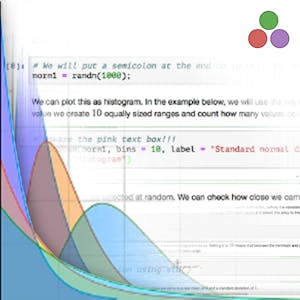Julia Scientific Programming
This four-module course introduces users to Julia as a first language. Julia is a high-level, high-performance dynamic programming language developed specifically for scientific computing. This language will be particularly useful for applications in physics, chemistry, astronomy, engineering, data science, bioinformatics and many more. As open source software, you will always have it available throughout your working life. It can also be used from the command line, program files or a new type of interface known as a Jupyter notebook (which is freely available as a service from JuliaBox.com).Julia is designed to address the requirements of high-performance numerical and scientific computing while also being effective for general-purpose programming. You will be able to access all the available processors and memory, scrape data from anywhere on the web, and have it always accessible through any device you care to use as long as it has a browser. Join us to discover new computing possibilities. Let’s get started on learning Julia.
By the end of the course you will be able to:
- Programme using the Julia language by practising through assignments
- Write your own simple Julia programs from scratch
- Understand the advantages and capacities of Julia as a computing language
- Work in Jupyter notebooks using the Julia language
- Use various Julia packages such as Plots, DataFrames and Stats
The course is delivered through video lectures, on-screen demonstrations, quizzes and practical peer-reviewed projects designed to give you an opportunity to work with the packages.
None
Syllabus
Syllabus - What you will learn from this course
Week 1
Welcome to the course
Week 2
A context for exploring Julia: Working with data
Week 3
Notebooks as Julia Programs
Week 4
Structuring data and functions in Julia
FAQ
When will I have access to the lectures and assignments?
Access to lectures and assignments depends on your type of enrollment. If you take a course in audit mode, you will be able to see most course materials for free. To access graded assignments and to earn a Certificate, you will need to purchase the Certificate experience, during or after your audit. If you don't see the audit option:
What will I get if I purchase the Certificate?
When you purchase a Certificate you get access to all course materials, including graded assignments. Upon completing the course, your electronic Certificate will be added to your Accomplishments page - from there, you can print your Certificate or add it to your LinkedIn profile. If you only want to read and view the course content, you can audit the course for free.
Is financial aid available?
Yes. In select learning programs, you can apply for financial aid or a scholarship if you can’t afford the enrollment fee. If fin aid or scholarship is available for your learning program selection, you’ll find a link to apply on the description page.
Reviews
The course started out well wit goof balance between lectures and applications during the first three weeks. Towards the end it felt rushed with too much content crammed into the last week.
I thoroughly enjoyed this course. The material is very clear and the exercises were enjoyable. Keen to learn more! It would be great to see an advanced Julia course here!
Good and enthusiastic teachers. I found the difficulty a bit too easy but it was a good introductory course and I was new to Julia, so it served its purpose.
Amazing course! I learned a lot during this course. The assignments made me improve my coding skills and the questions were challenging enough. The instructors are engaging and innovative!
